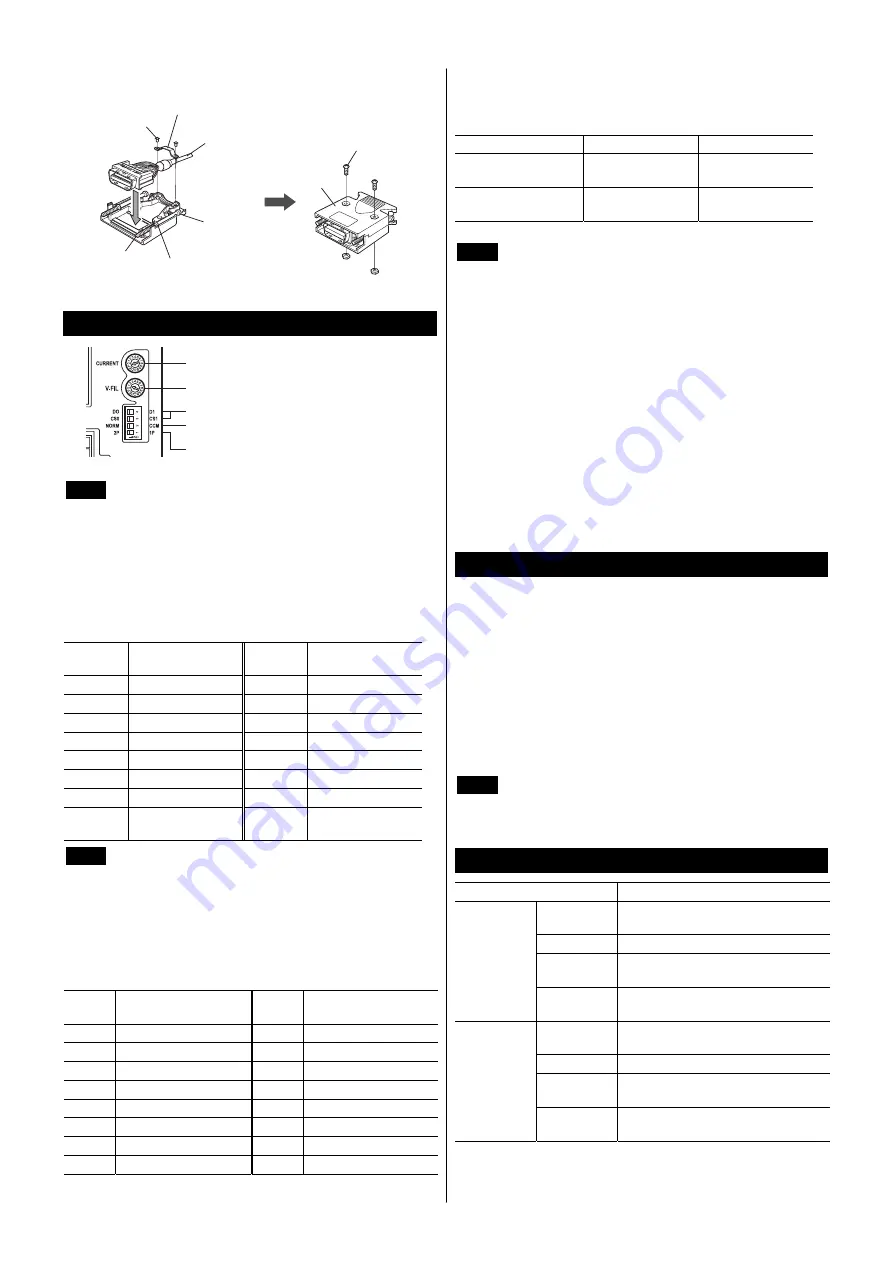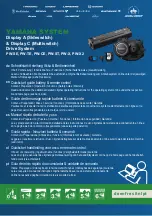
7
•
Assembling the connector
I/O signal cable
Cable clamp
Screw (M2.5)
Case
Connector
Place the spring
washer outside
the case.
Screw (M2)
Screw (M2.5)
Tightening torque:
0.5 to 0.55 N·m
(71 to 78 oz-in)
Align the washer in the
depression in the case.
Setting
㪚㫌㫉㫉㪼㫅㫋㩷㫊㪼㫋㫋㫀㫅㪾㩷㫊㫎㫀㫋㪺㪿㩷䋨㪫㪿㪼㩷㪽㪸㪺㫋㫆㫉㫐㩷㫊㪼㫋㫋㫀㫅㪾㩷㫀㫊㩷㵰㪝㪅㵱䋩
㪪㫇㪼㪼㪻㩷㪽㫀㫃㫋㪼㫉㩷㫊㪼㫋㫋㫀㫅㪾㩷㫊㫎㫀㫋㪺㪿㩷䋨㪫㪿㪼㩷㪽㪸㪺㫋㫆㫉㫐㩷㫊㪼㫋㫋㫀㫅㪾㩷㫀㫊㩷㵰㪈㪅㵱䋩
㪩㪼㫊㫆㫃㫌㫋㫀㫆㫅㩷㫊㫎㫀㫋㪺㪿㪼㫊㩷䋨㪫㪿㪼㩷㪽㪸㪺㫋㫆㫉㫐㩷㫊㪼㫋㫋㫀㫅㪾㩷㫀㫊㩷㵰㪛㪇㪃㩷㪚㪪㪇㪅㵱䋩
㪧㫌㫃㫊㪼㩷㫀㫅㫇㫌㫋㩷㫄㫆㪻㪼㩷㫊㪼㫃㪼㪺㫋㫆㫉㩷㫊㫎㫀㫋㪺㪿
䋨㪫㪿㪼㩷㪽㪸㪺㫋㫆㫉㫐㩷㫊㪼㫋㫋㫀㫅㪾㩷㫀㫊㩷㵰㪦㪝㪝㪅㵱䋩
㪚㫆㫅㫋㫉㫆㫃㩷㫄㫆㪻㪼㩷㫊㪼㫃㪼㪺㫋㫆㫉㩷㫊㫎㫀㫋㪺㪿
䋨㪫㪿㪼㩷㪽㪸㪺㫋㫆㫉㫐㩷㫊㪼㫋㫋㫀㫅㪾㩷㫀㫊㩷㵰㪥㪦㪩㪤㪅㵱䋩
Note
The new settings of the resolution switches or pulse
input mode select switch will become effective after the
power is cycled. If a 24 VDC power supply is used, also
cycle the 24 VDC power supply.
Operating current
The operating current can be set using the current setting switch. The
operating current is set with the value which multiplied the
maximum output current by the operating current rate (%).
Dial
setting
Operating current
rate (%)
Dial
setting
Operating current
rate (%)
0 6.3 8 56.3
1 12.5 9 62.5
2 18.8 A 68.8
3 25.0 B 75.0
4 31.3 C 81.3
5 37.5 D 87.5
6 43.8 E 93.8
7 50.0 F
100
(factory setting)
Note
If the operating current is too low, starting of the
actuator and its position hold function may be affected.
Do not lower the operating current more than
necessary.
Speed filter
The actuator response to input pulses can be adjusted using the speed
filter setting switch (V-FIL).
Dial
setting
Speed filter time
constant (ms)
Dial
setting
Speed filter time
constant (ms)
0 0 8 30
1
1 (factory setting)
9
50
2 2 A 70
3 3 B
100
4 5 C
120
5 7 D
150
6 10 E 170
7 20 F 200
Resolution
The resolution per revolution of the motor output shaft can be set
using the resolution switches.
Resolution switches
D0
D1
CS0
1000 P/R
(0.36°/pulse)
∗
500 P/R
(0.72°/pulse)
CS1
10000 P/R
(0.036°/pulse)
5000 P/R
(0.072°/pulse)
∗
Factory setting
Note
When changing the resolution using the CS input, use
the switches in “CS0”/“D0” or “CS0”/“D1” combination. If
the CS input is turned ON when “CS1” is selected, the
resolution will not be changed.
Control mode
The control mode of the driver can be toggled between the normal
mode and current control mode using the control mode selector
switch.
NORM: Normal mode
CCM: Current control mode
Pulse input mode
The pulse input mode of the driver can be set using the pulse input
mode selector switch.
OFF: 2-pulse input mode
ON: 1-pulse input mode
Inspection
It is recommended that periodic inspections be conducted for the
items listed below after each operation of the actuator. If an
abnormal condition is noted, discontinue any use and contact your
nearest office.
During inspection
•
Check for a blocked opening of the driver case.
•
Are any of the driver mounting screws or power connection
terminal screws loose?
•
Is there attachment of dust, etc., on the driver?
•
Are there any strange smells or appearances within the driver?
Note
The driver uses semiconductor elements. Handle the
driver with care since static electricity may damage
semiconductor elements. Static electricity may damage
the driver.
General specifications
Degree of protection
IP20
Ambient
temperature
0 to +50 °C (+32 to +122 °F)
(non-freezing)
Humidity
85% or less (non-condensing)
Altitude
Up to 1000 m (3300 ft.) above sea
level
Operation
environment
Surrounding
atmosphere
No corrosive gas, dust, water or oil
Ambient
temperature
−
20 to +60 °C (
−
4 to +140 °F)
(non-freezing)
Humidity
85% or less (non-condensing)
Altitude
Up to 3000 m (10000 ft.) above sea
level
Storage
environment
Shipping
environment
Surrounding
atmosphere
No corrosive gas, dust, water or oil




































